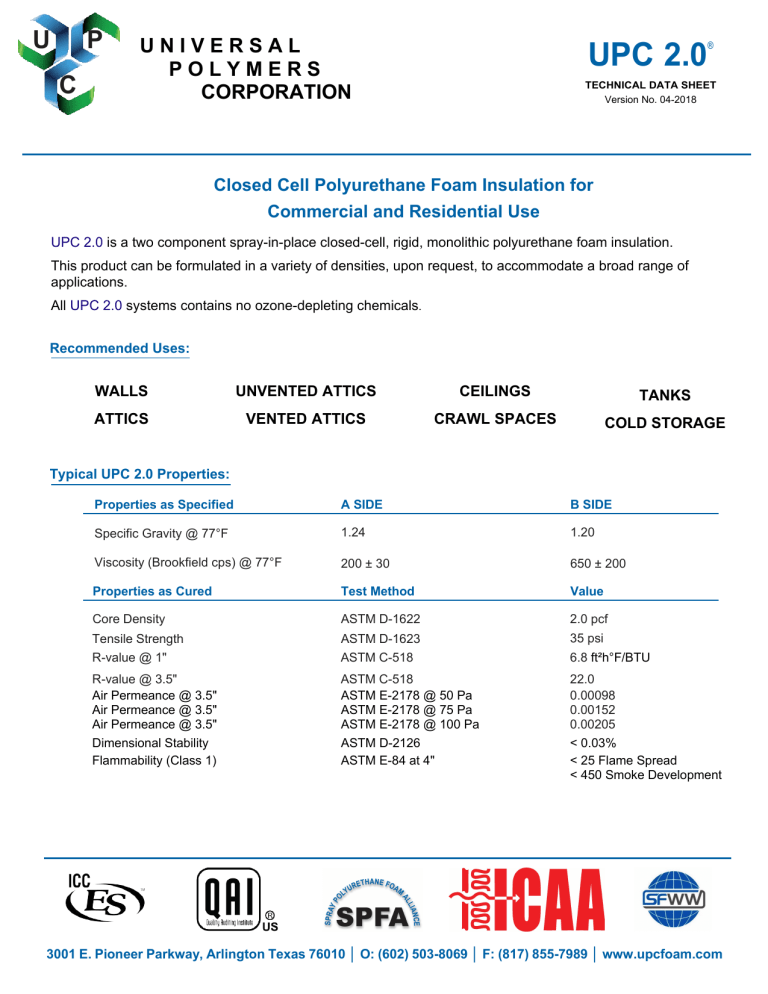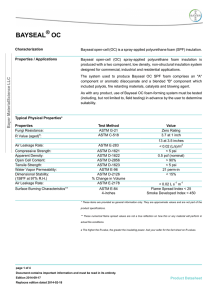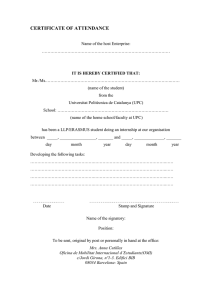
U P C UPC 2.0 UNIVERSAL POLYMERS CORPORATION ® TECHNICAL DATA SHEET Version No. 04-2018 Closed Cell Polyurethane Foam Insulation for Commercial and Residential Use UPC 2.0 is a two component spray-in-place closed-cell, rigid, monolithic polyurethane foam insulation. This product can be formulated in a variety of densities, upon request, to accommodate a broad range of applications. All UPC 2.0 systems contains no ozone-depleting chemicals. Recommended Uses: WALLS UNVENTED ATTICS CEILINGS TANKS ATTICS VENTED ATTICS CRAWL SPACES COLD STORAGE Typical UPC 2.0 Properties: Properties as Specified A SIDE B SIDE Specific Gravity @ 77°F 1.24 1.20 Viscosity (Brookfield cps) @ 77°F 200 ± 30 650 ± 200 Properties as Cured Test Method Value Core Density ASTM D-1622 2.0 pcf Tensile Strength R-value @ 1" ASTM D-1623 ASTM C-518 35 psi R-value @ 3.5" Air Permeance @ 3.5" Air Permeance @ 3.5" Air Permeance @ 3.5" Dimensional Stability Flammability (Class 1) ASTM C-518 ASTM E-2178 @ 50 Pa ASTM E-2178 @ 75 Pa ASTM E-2178 @ 100 Pa ASTM D-2126 ASTM E-84 at 4" 22.0 0.00098 0.00152 0.00205 < 0.03% < 25 Flame Spread < 450 Smoke Development 6.8 ft²h°F/BTU 3001 E. Pioneer Parkway, Arlington Texas 76010 │ O: (602) 503-8069 │ F: (817) 855-7989 │ www.upcfoam.com Processing Parameters: Store materials between 65º to 85ºF in a dry and well-ventilated area. Material in containers should be maintained at 75ºF to 90ºF while in use. Conditioned trailers or tanks may be necessary. Material temperature should be confirmed with a thermometer or an infrared gun. Processing Equipment 2:1 transfer pumps are recommended for material transfer from container to the proportioner. The plural component proportioner must be capable of supplying each component within ± 2% of the desired 1:1 mixing ratio by volume. Health and Safety Information, (Cont.) AX-171 Course 101-R Chapter 1: Health, Safety and Environmental Aspects of Spray Polyurethane Foam and Coverings and the following document is available from the Center for the Polyurethanes Industries (CPI): Model Respiratory Protection Program for Compliance with the Occupational Safety and Health Administration’s Respiratory Protection Program Standard 29 C.F.R.§1910.134 As with all SPF systems improper application techniques should be avoided. Examples of improper application techniques include, but are not limited to excessive thickness of SPF, off-ratio material and spraying into or under rising SPF. Hose heaters should be set to deliver 115ºF to 140ºF materials to the spray gun. These settings will ensure thorough mixing in the spray gun mix chamber in typical applications. Optimum hose pressure and temperature will vary with equipment type and condition, ambient and substrate conditions, and the specific application. Some equipment may require you to warm containers to achieve optimum material temperature. It is the responsibility of the applicator to properly interpret equipment technical literature, particularly information that relates to acceptable combinations of gun chamber size, proportioner output, and material pressures. The relationship between proper chamber size and the capacity of the proportion’s pre-heater is critical. Potential results of improperly installed SPF include dangerously high reaction temperatures that may result in fire and offensive odors that may or may not dissipate. Improperly installed SPF must be removed and replaced with properly installed materials. To ensure optimum performance, a minimum pass of 1” is recommended with no limit pass thickness. All substrates must be dry at time of apply. Cautions and Recommendations: UPC 2.0 is designed for an application rate of one inch minimum to 6 inches’ maximum per pass. Once installed material has cooled it is possible to add additional applications to increase the overall installed thickness of SPF. This application procedure complies with the Spray Polyurethane Foam Alliance (SPFA®). UPC 2.0 is not designed for use as an exterior roofing system. Equipment Settings: Chemical Drum Temp. Pre-Heat: ISO (A) Pre-Heat: Resin (B) Hose Heat: Spray Pressure Above 75°F 115°F to 140°F 115°F to 140°F 115°F to 140°F 1000 to 1400 psi (dynamic) Large masses of SPF should be removed to an outside safe area, cut into smaller pieces and allowed to cool before discarding into any trash receptacle. SPF insulation is combustible. High-intensity heat sources such as welding or cutting torches must not be used in contact with or near UPC 2.0 or any polyurethane foam. UPC 2.0 is designed for installation in most standard construction configurations using common materials such as wood and wood products, metal and concrete. Shelf Life and Storage: UPC 2.0 has a shelf life of approximately six months from the date of manufacture when stored in original, unopened containers at 50-80°F. As with all industrial chemicals this material should be stored in a covered, secure location and never in direct sunlight. Storage temperatures above the recommended range will shorten shelf life. . Foam plastic materials installed in walls or ceilings may present a fire hazard unless protected by an approved, fire- resistant thermal barrier with a finish rating of not less than 15 minutes as required by building codes. Rim joists/header areas, in accordance with the IRC® and IBC® may not require additional protection. Foam plastic must also be protected against ignition by code-approved materials in attics and crawl spaces. See relevant Building Codes for more information. Health and Safety Information: Appropriate literature has been assembled which provides information concerning the health and safety precautions that must be observed when handling UPC 2.0 foam forming system. Before working with this product, you must read and become familiar with the available information on its risks, proper use and handling. This cannot be over emphasized. Information is available in several forms, e.g. Safety Data Sheet (SDS). Handling Information: Applicators should ensure the safety of the job-site and construction personnel by posting appropriate signs warning that all “hot work” such as welding, soldering, and cutting with torches should not take place until a thermal barrier or approved equivalent is installed over any exposed polyurethane foam. In addition to reading and understanding the SDS, all contractors and applicators must use appropriate respiratory, skin and eye Personal Protective Equipment (PPE) when handling and processing polyurethane chemical systems. Personnel should review the following document published by Spray Polyurethane Foam Alliance (SPFA®): Vapor Retarder: UPC 2.0 is intended for indoor applications, and is not a vapor retarder. It is vapor permeable and will allow for some diffusion of moisture through the insulation. The following considerations are needed: (1) A vapor retarder needs to be considered in the design of the building envelope in cold climates, such as zones 4 and higher in the U.S., as defined in 2004 Supplement to the IRC®, Table N 1101.2; (2) A vapor retarder also needs to be considered where high interior humidity conditions exist. Refer to local codes and manufacturer’s written specifications to ensurecompliance. DISCLAIMER: Please read all information in the general guidelines, technical data sheets, application guide and safety data sheets (SDS) before applying material. Published technical data and instructions are subject to change without notice. Contact your local Universal Polymers representative or visit our website for current technical data and instructions. All guidelines, recommendations, statements, and technical data contained herein are based on information and tests we believe to be reliable and correct, but accuracy and completeness of said tests are not guaranteed and are not to be construed as a warranty, either expressed or implied. It is the user’s responsibility to satisfy himself, by his own information and tests, to determine suitability of the product for his own intended use, application and job situation and user assumes all risk and liability resulting from his own use of the product. We do not suggest or guarantee that any hazards listed herein are the only ones that may exist. Neither seller nor manufacturer shall be liable to the buyer or any third party for any injury, loss or damage directly or indirectly resulting from use of, or inability to use, the product. Recommendations or statements, whether verbal or in writing, other than those contained herein shall not be binding upon the manufacturer, unless in writing and signed by a corporate officer of the manufacturer. Technical and application information is provided for establishing a general profile of the material and proper application procedures. Test performance results were obtained in a controlled environment and Universal Polymers makes no claim that these tests or any other tests, accurately represent all environments.


